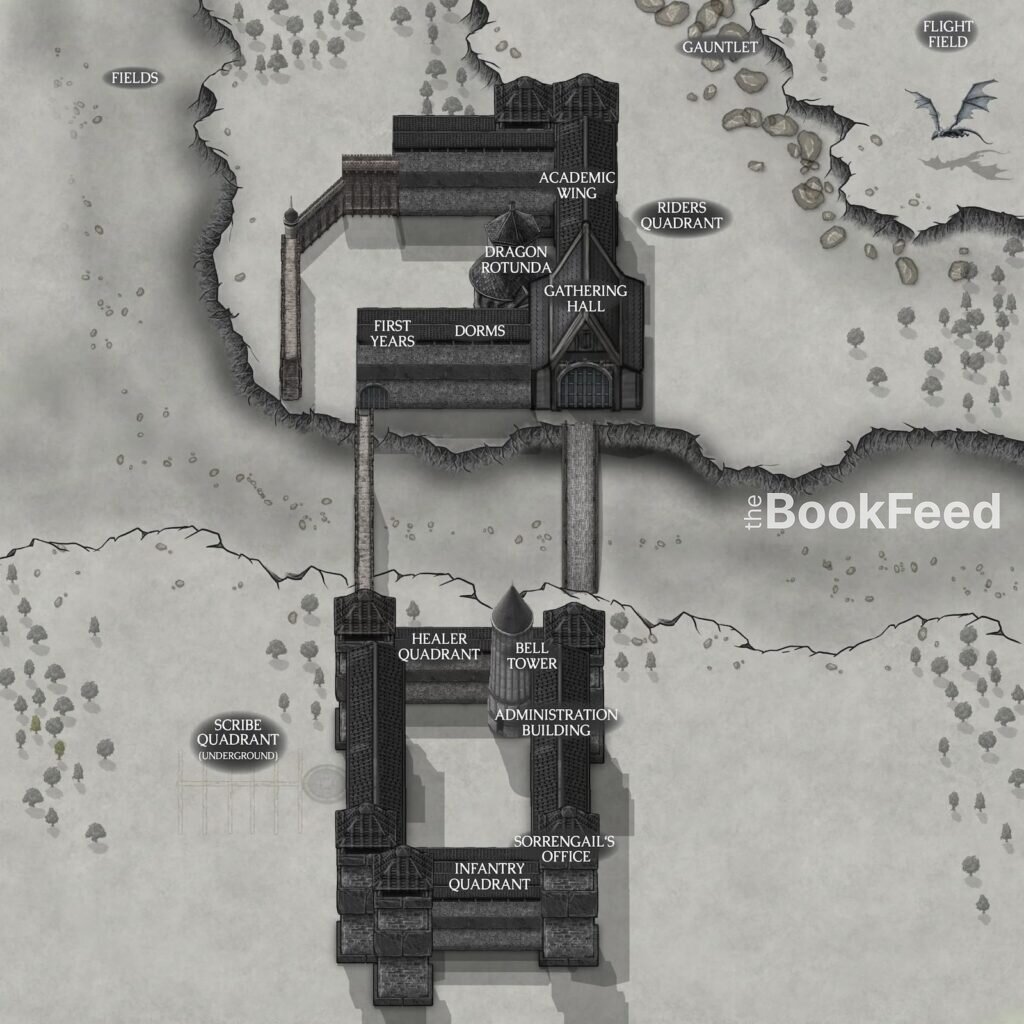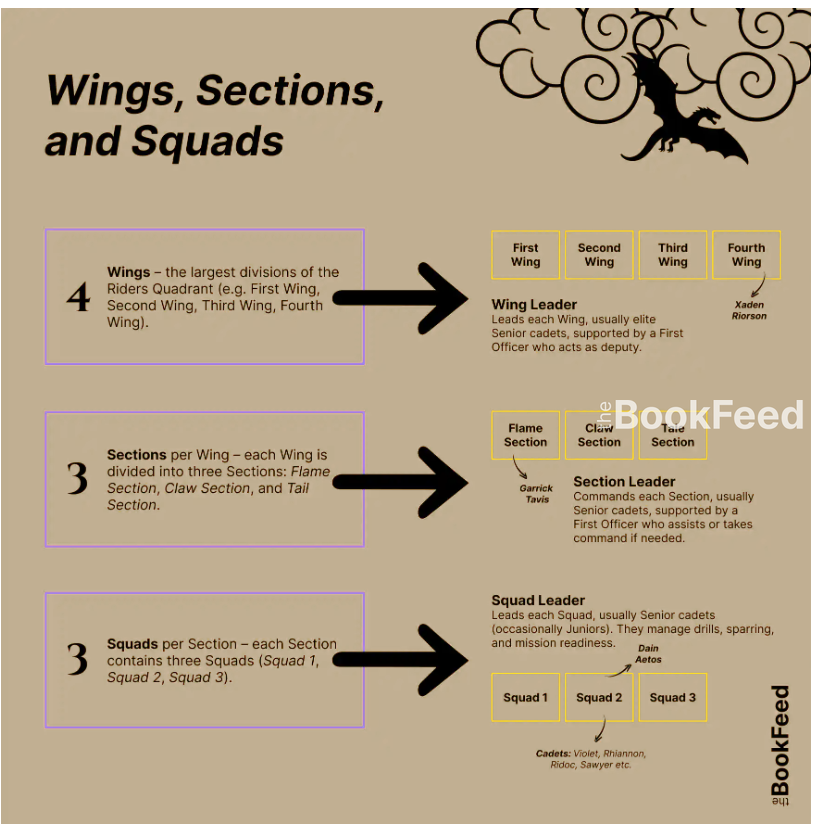| Type | War College |
|---|---|
| Located in | Morraine Province, Navarre |
| Head | General Aetos; Lilith Sorrengail † (formerly) |
| Appears in | Fourth Wing (2023), Iron Flame (2023), Onyx Storm (2025) |
Contents
Basgiath War College is the primary military academy of Navarre, established to train and commission officers, riders, healers, infantry, and scribes who serve in the nation’s armed forces. Known for its unforgiving standards and extreme mortality rate, Basgiath is regarded as both an honor and a death sentence for those conscripted or chosen to attend.
The college’s purpose is to identify and strengthen the most capable individuals in Navarre through relentless physical, mental, and tactical trials. From the moment cadets cross the Parapet—the perilous entry test separating candidates from civilians—they are subjected to a regime designed to eliminate weakness and reward strategic intelligence, endurance, and adaptability.
Location
Basgiath is located roughly in the middle of Navarre, built into the side of Basgiath Mountain in the Morraine Province. The main complex is divided into two primary sections: the lower portion, which houses the Scribe, Healer, Infantry, and Administrative Quadrants, and the upper portion, known as the Citadel, which serves as the base for the Rider Quadrant. The fortress appears as though it were carved directly from the mountain’s ridgeline, its high battlements rising above the grassy fields below.
The structure features four defensive turrets, one at each corner, with the southern turret containing the bells. A worn cobblestone path runs alongside this turret near General Sorrengail’s office. Four main roads ascend the mountain and converge on the fields beneath the fortress, just below the main gate. The gate itself remains closed to incoming cadets during Conscription Day, as each quadrant maintains its own designated entrance.
The northern turret connects to the Infantry Quadrant at ground level. The southern gate provides access to the Healer Quadrant, while the central tunnel descends to the Archives and the Scribe Quadrant located below ground. The Rider Quadrant entrance differs from the others—a fortified door within a tower that requires cadets to climb upward toward the Citadel.
From its elevated position on Basgiath Mountain, the college overlooks the Iakobos River and the Vale, the region’s dragon hatching grounds, allowing direct access for rider training and patrols.

Training at Basgiath
Training at Basgiath War College lasts three years and consists of several stages designed to test and develop the physical, tactical, and academic abilities of every student. Throughout the entire program, all participants—regardless of their assigned quadrant—are referred to as cadets. Upon graduation, they enter active service in Navarre’s military, serving according to their specialization.
Preparation
Preparation for admission to Basgiath War College, particularly for the Rider Quadrant, often takes several years. Candidates typically undergo extensive physical conditioning and academic study before attempting entrance. However, some entrants, such as Violet Sorrengail, had significantly less preparation time. Originally intended for the Scribe Quadrant, Violet was reassigned to the Rider Quadrant by General Sorrengail only six months before Conscription Day.
Conscription Day
Conscription Day marks the formal beginning of training at Basgiath. Before arrival, all candidates must complete both written and physical agility examinations to qualify for their preferred quadrant. Those who fail the assessments are assigned to the Infantry Quadrant, while successful candidates may choose a quadrant based on their results and aptitude.
The Rider Quadrant differs from the others, as it accepts only volunteers and the 107 children of the rebellion. Candidates for this quadrant must complete an additional entry trial: the crossing of the Parapet, a narrow stone viaduct suspended high above a chasm. Only those who survive the crossing are admitted into rider training.
Special Case: The Children of the Rebellion
Among the Rider Quadrant’s candidates are the so-called children of the rebellion, also referred to as the marked. These individuals bear the rebel’s mark, identifying them as descendants of those who participated in the failed rebellion. As punishment for their parents’ actions, they are required to serve in the Rider Quadrant, where survival is uncertain.
Duration of Training
The full program at Basgiath War College extends over three years. During this time, cadets progress through increasingly difficult academic, tactical, and combat trials intended to prepare them for active duty. Communication with family members is restricted during the first year; only second- and third-year cadets are permitted to send or receive letters. In the event of a cadet’s death, families may choose to retrieve the body and personal effects for burial or burning, or allow the college to conduct the rites within its grounds, interring the remains beneath the fields beyond Basgiath.
Upon completion of training, all graduates of Basgiath War College are commissioned into Navarre’s armed forces, serving in the ongoing war against the kingdom of Poromiel and its griffin riders.
Quadrants of Basgiath
Cadets are divided into four quadrants, each serving a specific role within Navarre’s military structure:
- The Rider Quadrant, where cadets train to bond with dragons and fight as aerial combatants.
- The Healer Quadrant, responsible for battlefield medicine and restoration.
- The Scribe Quadrant, charged with recording, analyzing, and preserving knowledge.
- The Infantry Quadrant, composed of ground soldiers who form the bulk of Navarre’s army.
While all quadrants demand discipline and sacrifice, the Rider Quadrant is the most feared and prestigious. The process of dragon bonding, the constant risk of death during training, and the political tension between lineages make it the defining feature of Basgiath’s legacy.
Cadets at Basgiath War College are divided into four quadrants according to aptitude, specialization, and the needs of Navarre’s military. Each quadrant operates independently, maintaining its own instructors, uniforms, and training facilities. Together, the four quadrants form the foundation of Navarre’s defense, healing, scholarship, and record keeping.
Riders Quadrant
The Riders Quadrant trains cadets to bond with dragons and serve as Navarre’s elite aerial force. Entry is limited to volunteers and the 107 children of the rebellion. On Conscription Day, candidates must survive the crossing of the Parapet, a narrow bridge spanning a deep chasm, before beginning their first year of training.
Training and Duties: Cadets undergo combat and endurance instruction, tactical education, and survival trials such as the Gauntlet and Threshing. Bonded riders develop individual signets linked to their dragons.
Location and Facilities: The quadrant occupies the Citadel, the upper levels of Basgiath War College. The Citadel includes barracks, classrooms, command offices, and the Flight Field, where dragons land and train.
Uniform: Rider cadets wear black riding leathers reinforced for aerial combat. Rank and squad affiliation are displayed through insignia on the shoulder or collar.
Healer Quadrant
The Healer Quadrant is responsible for providing medical care to cadets and riders across all divisions. Healers rely on anatomical knowledge, herbal medicine, and surgical skill, and often assist menders who heal through signets.
Training and Duties: Healer cadets study anatomy, pharmacology, triage, and field medicine. They assist during Conscription Day, the Gauntlet, and Threshing, when injuries are frequent. Cadets rotate between classroom instruction, surgery wards, and on-site field assignments to master both routine and emergency care.
Location and Facilities: Located on the southern end of Basgiath, the quadrant connects to the Riders’ Citadel by a covered stone bridge over the ravine. The area includes the infirmary, apothecary labs, classrooms, and rest wards. The infirmary operates continuously to treat injuries sustained during trials and training.
Uniform: Healer cadets wear pale blue uniforms, signifying their role in preservation and recovery.
Culture and Practices: The quadrant emphasizes composure, compassion, and precision. Training combines practical medicine with ethical study. Foundational texts include Major Frederick’s Modern Guide for Healers, which promotes self-reliance and experimental adaptation.
Scribe Quadrant
The Scribe Quadrant safeguards and interprets the written history of Navarre. Its cadets serve as historians, translators, and archivists responsible for maintaining state and military records. Their work ensures continuity of governance, strategy, and knowledge.
Location and Facilities: The Scribe Quadrant lies beneath the main fortress, accessible through descending tunnels lit by mage lamps. The Archives form the core of the complex, surrounded by classrooms, study rooms, and dormitories.
Training and Duties: Cadets study history, law, linguistics, mathematics, and cartography. They are trained in transcription, translation, and the preservation of written materials. Instruction demands accuracy, discretion, and loyalty to the truth contained within the archives.
Uniform: Scribe cadets wear cream tunics with hoods, designed to blend with parchment and shelves of tomes. The hood symbolizes humility and the principle that no one stands above the written word. Gold rectangles woven into the shoulders of the tunic indicate the cadet’s year of study.
Notable Locations:
- The Archives: A vast subterranean repository of nearly all recorded texts in Navarre.
- The Royal Vault: A sealed chamber within the Archives accessible only to those of royal lineage.
- Workrooms and Classrooms: Identical transcription halls used for copying, translation, and research.
Infantry Quadrant
The Infantry Quadrant is the largest of the four divisions, training over a thousand cadets to form the backbone of Navarre’s ground forces. Most conscripts are assigned here to provide manpower for the kingdom’s ongoing conflicts.
Location and Facilities: Situated at ground level near the northern turret, the quadrant includes extensive barracks, open-air training fields, a mess hall, and the Infantry Amphitheater used for assemblies and instruction.
Training and Duties: Cadets focus on endurance, formation tactics, and weapons mastery. Instruction covers survival in harsh conditions, navigation, and winter campaigns. From the second year onward, Infantry units participate in joint operations with Riders, Healers, and Scribes to simulate real battlefield coordination.
Uniform: Infantry cadets wear navy blue uniforms with rank patches identifying leadership. Battalion commanders—equivalent to Wingleaders in the Riders Quadrant—display an open triangle beneath two oak leaves on the shoulder.
Culture: Life in the Infantry Quadrant is harsh and regimented, emphasizing obedience, stamina, and teamwork over individual ambition. The training schedule is relentless, preparing cadets for the physical and psychological demands of war.
Riders Quadrant at Basgiath
The Riders Quadrant stands at the center of life at Basgiath War College. Most of the academy’s reputation and focus revolve around the training of dragon riders, who form the elite aerial defense force of Navarre. The following sections describe the subjects taught within the quadrant, the key examinations and trials cadets must complete, and the internal hierarchy of squadrons, wings, and units.
Subjects Taught in the Riders Quadrant
Before establishing contact with dragons, cadets of the Riders Quadrant attend a series of academic and military courses intended to prepare them for combat, survival, and aerial warfare. Instruction covers both theoretical and practical disciplines:
- Formation: Conducted by Professor Markham of the Scribe Quadrant. Cadets receive daily briefings on the current political and military situation in Navarre.
- Battle Brief: Taught by Professor Devera. This course covers strategic planning, battlefield formations, and both offensive and defensive maneuvers.
- History: Lasts one hour, held directly before Battle Brief, and focuses solely on reviewing past wars.
- Dragon Studies: Led by Professor Kaori. Cadets learn about the various dragon species, their colors, temperaments, and behavioral patterns, as well as the principles of dragon interaction.
- Wielding: Instructed by Professor Carr. Only cadets who have successfully bonded with a dragon and manifested a signet are permitted to attend. The subject focuses on signet control and ethical usage.
- Close- and Ground-Combat: Taught by Professor Emetterio. Cadets participate in sparring sessions to develop their hand-to-hand and melee combat skills. Combat may be armed or unarmed; the use of signets during sparring results in an official warning.
- Rider Survival Course (RSC): Instructed by Professor Grady, trains cadets in essential survival skills for riders, including endurance, navigation, and battlefield adaptability.
Before establishing contact with dragons, cadets of the Riders Quadrant attend a series of academic and military courses intended to prepare them for combat, survival, and aerial warfare. Instruction covers both theoretical and practical disciplines:
Trials and Examinations in the Riders Quadrant
The Parapet Crossing
On Conscription Day, candidates for the Riders Quadrant must cross the Parapet, a narrow stone bridge linking the Riders’ Citadel to the main college. The bridge is approximately 45 centimeters wide, suspended 60 meters above the chasm below, with no railing or barrier. Candidates first climb 250 steps in a tower to reach it. High winds and limited visibility caused by fog make the crossing extremely dangerous. Roughly 15 percent of candidates die attempting it, with losses reaching 18 percent at the beginning of Fourth Wing.
Challenges
The Challenges are formal sparring duels between cadets. Fights take place both armed and unarmed. The use of signets is prohibited but punished only with a warning if employed. These challenges train cadets in discipline, adaptability, and combat awareness.
The Gauntlet
The Gauntlet is a large obstacle course carved into the mountainside separating the Riders’ Citadel from the Flight Field and the dragons’ vale. It consists of five sections, each increasing in difficulty, designed to test the physical and mental attributes required of riders. Cadets receive nine training sessions before attempting the final Gauntlet examination on 29 September. Assistance during the course is forbidden, and many candidates die during the trial due to exhaustion or falls. Successful completion allows progression to the Presentation stage.
Presentation
After the Gauntlet, cadets participate in the Presentation, where dragons observe the candidates for the first time. The event allows dragons to assess potential riders before Threshing. Improper behavior toward dragons can lead to instant death. Some dragons make their selection during this stage, sending mental signals to favored candidates.
Threshing
Threshing takes place annually on 1 October, roughly three months after the start of training. Surviving candidates who completed the Gauntlet and Presentation are released into the field to meet the dragons. Threshing is a lethal event—violence between candidates is permitted, and dragons may kill at will. The process lasts from morning until nightfall. Candidates who fail to bond but survive may return the following year as returners. When a dragon chooses a rider, the pair undergoes an initial flight test; if the rider falls, the dragon may choose to catch or abandon them. After landing successfully, the dragon reveals its full name, which the rider must report to a scribe. Once verified against the official dragon registry, the bond becomes permanent. From that moment, the candidate becomes a rider cadet and full member of the Riders Quadrant.
Squad Battles
The Squad Battles are inter-squad competitions held between cadets of different years. These exercises test tactical thinking, teamwork, and leadership across squads and wings. They simulate reconnaissance and combat missions relevant to active military service.
War Games
The War Games are multi-day simulated combat exercises designed to replicate real warfare scenarios. Squadrons, wings, and units compete against each other in strategic operations that prepare cadets for potential engagements with Poromiel and its griffin riders. The exercises test endurance, command efficiency, and battlefield coordination.
First-Year Survival Breakdown
From 368 cadets on the parapet to just 79 survivors. Forged by dragonfire. 💀🐉
Hierarchical Structure of the Riders Quadrant
General Melgren is the supreme commander of Navarre’s military forces and the only officer ranking above General Lilith Sorrengail (now General Aetos), commandant of Basgiath War College. He holds overall authority over all wings of the Riders Quadrant and directs the deployment of Navarre’s troops in warfare, defense, and reconnaissance operations.
Candidate
Individuals who attempt to enter the Riders Quadrant. Candidates must survive the Parapet crossing on Conscription Day to be accepted as cadets.
Cadet
Those who have survived the Parapet and are officially enrolled in the Riders Quadrant. Cadets undergo three years of education and military training, including combat, strategy, and dragon studies.
Rider (Bonded Cadet)
A cadet who has successfully bonded with a dragon. While still classified as a cadet, their title is elevated to reflect their new status as a bonded rider.
Junior Rider
Second-year cadets continuing their training and active participation in field exercises and tactical drills.
Senior Rider
Third-year cadets who hold seniority within the Riders Quadrant and often mentor lower-year cadets.
Wing Leader
The commanding officer of one of the four Wings. Responsible for the training, organization, and performance of the entire wing. Each Wing Leader is supported by an Executive Officer (Second-in-Command).
Section Leader
Each Wing consists of three Sections. A Section Leader commands their section and oversees the activities of its three squads.
Squad Leader
Each Section is composed of three Squads, each led by a Squad Leader and assisted by a Second-in-Command. Squads typically consist of 15–20 cadets.
First Officer (Executive Officer)
A deputy assigned to assist Wing, Section, or Squad Leaders in administrative and command responsibilities. The First Officer acts as a temporary leader if the commanding officer is incapacitated or absent.
Officer (Post-Graduation)
Upon completing their three-year training, cadets graduate as commissioned officers in Navarre’s military. Their subsequent ranks and assignments depend on performance and dragon pairing. Some graduates remain at Basgiath as instructors.
Uniforms and Insignia
All riders wear black uniforms, commonly referred to as riders’ black. The number of silver stars on the uniform indicates the cadet’s year of study:
- One star – first-year cadet
- Two stars – second-year cadet
- Three stars – third-year cadet
Insignia are displayed on standard academy uniforms only; combat gear is unmarked to conceal rank and power level from enemies.
Known insignia include:
- Wing Insignia: Indicates Wing, Section, and Squad affiliation (e.g., Fourth Wing, Flame Section, Squad 2). Violet Sorrengail’s insignia bears a wing symbol, a flame, and the number 2.
- Classified Signet Insignia: A neutral compass rose marking cadets whose signet powers are classified.
- Gauntlet Insignia: Awarded to the cadet who completes the Gauntlet obstacle course in the fastest time.
- Iron Squad Insignia: Given to the squadron with the highest survival rate after Threshing; earned by Violet’s squad in Fourth Wing.
- Sword Insignia: Denotes excellence in close combat; worn by Garrick Tavis.
- Green Insignia: Worn by Imogen, though its meaning is not officially defined.
Wings, Sections, and Squads
The Riders Quadrant at Basgiath follows a structured, four-tiered organization that defines command hierarchy, training groups, and combat coordination. This system mirrors the structure of Navarre’s broader military forces and ensures discipline, communication, and efficiency among riders.
Organizational Structure
- 4 Wings – the largest divisions of the Riders Quadrant (e.g., First Wing, Second Wing, Third Wing, Fourth Wing).
- 3 Sections per Wing – each Wing is divided into three Sections, typically named Flame Section, Claw Section, and Tail Section.
- 3 Squads per Section – each Section contains three Squads (Squad 1, Squad 2, Squad 3).
15–20 cadets per Squad – each Squad has a Squad Leader and a Second-in-Command responsible for the daily coordination and discipline of its members.

Leadership Roles within the Riders Quadrant
Wing Leaders
Each of the four Wings is commanded by a Wing Leader, typically an elite cadet from the third year (Senior) class. The Wing Leader oversees all Sections and Squads within their Wing and is responsible for strategic planning, discipline, and the performance of their riders. Every Wing Leader is assisted by a First Officer (Executive Officer), who supports daily operations and acts as deputy commander when necessary.
Section LeadersEach Wing’s three Sections are led by Section Leaders, who are also generally Senior cadets selected for leadership ability and combat performance. Like Wing Leaders, they are supported by a First Officer who assists in management and may assume command if required.
Squad Leaders
Each Section’s three Squads are led by Squad Leaders, usually drawn from the third-year (Senior) cadets, though exceptional second-year (Junior) cadets may also hold the position. Dain Aetos, for instance, served as Squad Leader of Squad 2, Flame Section, Fourth Wing while still a Junior. Squad Leaders maintain direct command over their units and handle tactical drills, sparring coordination, and mission readiness.
Notable Places
| The Parapet | A two-hundred-foot-high stone bridge only eighteen inches wide, connecting the lower fortress to the Riders Quadrant. Crossing it on Conscription Day is the first test of rider candidates; failure means certain death. |
|---|---|
| The Courtyard | The central mustering ground of the Riders Quadrant, capable of holding an entire wing of cadets. It connects directly to the citadel and its halls. |
| Dragon Rotunda | A vast, domed chamber linking the dorms, commons, and academic wing. Six towering marble dragon statues encircle the room, making it one of Basgiath’s most striking architectural features. |
| Academic Wing | Contains key training facilities for riders: Battle Brief Room, Sparring Gym, Burn Pit |
| The Forge | Heated by dragon fire, it houses Navarre’s only known luminary prior to Iron Flame. Essential for forging alloy weapons that sustain the wards. |
| Flight Field | A secluded box canyon atop the Gauntlet, used for dragon landings, takeoffs, and presentation ceremonies. Entry is forbidden to unbonded cadets. |
| The Gauntlet | A grueling obstacle course carved into the mountainside, designed to test physical skill, balance, and determination before cadets may reach the Flight Field. |
| The Vale | Adjacent to Basgiath, this sacred valley serves as dragonkind’s hatching grounds and the site of Threshing. It anchors Navarre’s wardstone and wards. |














